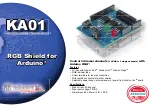
Preliminary Technical Data
UG-1828
Rev. PrC | Page 161 of 338
a multiple of agcUnderRangeLowInterval. Finally, when the signal level is increased above hbUnderRangeMidThresh, the gain is
incremented by hbGainStepHighRecovery following the expiry of agcUnderRangeHighInterval, which is a multiple of
agcUnderRangeMidInterval.
The multiple thresholds and interval parameters allow for faster gain recovery. Typically, agcUnderRangeHighInterval could be set to gain
update counter as shown in Figure 152. Therefore, when the signal level is below the mid and low thresholds, the recovery could happen
multiple times within a single gain update counter, which makes the recovery much faster. Note in “fast recovery” mode, gain recovery
might not always happen at the expiry of the gain update counter, which is different from the mode without “fast recovery”. If the gain
update counter is set to align with the frame or subframe boundary, it is possible that a fast recovery could happen in the middle of a
frame or subframe. Therefore, it is recommended to not use “fast recovery” mode when there is a stringent requirement for keeping a
constant gain for an entire frame or subframe.
Figure 152. AGC operation with HB Detector in Fast Recovery Mode
It is highly recommended that the apdHighThresh and hbHighThresh are set to an equivalent dBFS value. Likewise, it is highly
recommended that the apdLowThresh and the hbUnderRangeHighThresh are set to equivalent values. This equivalence will be
approximate, as these thresholds have unique threshold settings and will not be exactly equal. This section discusses the relevant priorities
between the detectors and how the AGC reacts when multiple threshold detectors have been exceeded. Table 64 shows the priorities
between the detectors when multiple overranges occur.
Table 64. Priorities of Attack Gain Steps
apdHighThresh Over Range
hbHighThresh Over Range
Gain Change
No
No
No Gain Change
No
Yes
Gain Change by hbGainStepAttack
Yes
No
Gain Change by apdGainStepAttack
Yes
Yes
Gain Change by apdGainStepAttack
For recovery, the number of thresholds is dependent on whether fast recovery is enabled or not. Considering the fast recovery scenario,
the priority of the thresholds is:
1.
hbUnderRangeLowThresh Underrange Condition
2.
hbUnderRangeMidThresh Underrange Condition
3.
hbUnderRangeHighThresh Underrange Condition
4.
apdLowThresh Underrange Condition
Upon one underrange condition, the AGC changes the gain by the corresponding gain step size of this condition. However, if multiple
conditions occur simultaneously, then the AGC prioritizes based on the priorities indicated; that is, if hbUnderRangeLowThresh is
reporting an under range condition then the AGC will adjust the gain by hbGainStepLowRecovery with two exceptions.
SIGNAL
LEVEL
hbHighTresh
hbUnderRangeHighTresh
hbUnderRangeMidTresh
hbUnderRangeLowTresh
INTERFERER
PRESENT
INTERFERER
REMOVED
GAIN INCREMENT
(hbGainStepHighRecovery)
GAIN INCREMENT
(hbGainStepLowRecovery)
agcUnderRangeLowInterval
agcUnderRangeMidInterval
agcUnderRangeHighInterval
GAIN INCREMENT
(hbGainStepMidRecovery)
24159-
110
















































